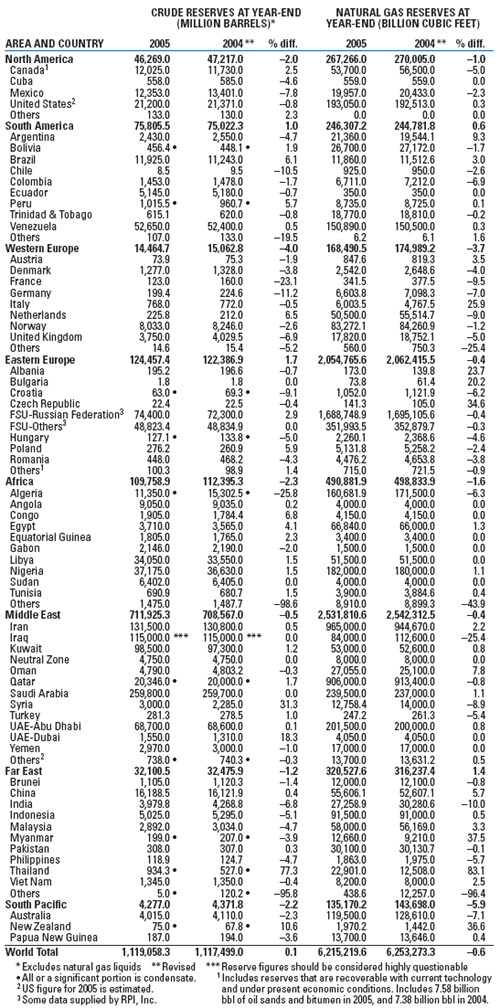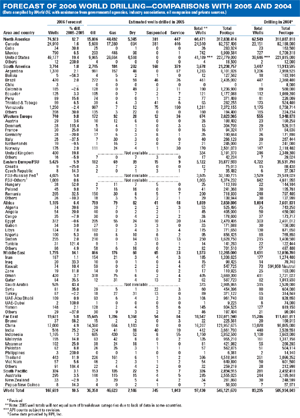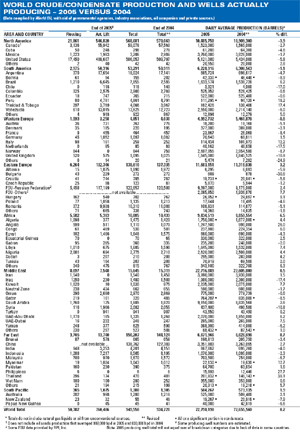International Outlook:
World Trends
High prices, instability keep activity high
In the face of continued strong demand for oil and gas, global crude and condensate output remained roughly even last year, as did reserves, while drilling reached heights not seen since the mid-1980s. This year, the exclamation point on drilling activity should be even more pronounced.
Futures crude prices have gone from a $48-to-$55/bbl range two years ago, to a $58-to-$68/bbl interval last year and now a $68-to-$78/bbl trading average in 2006. As this issue of World Oil went to press, the NYMEX price for WTI crude was rising back to the mid-$70s, due to the threat of new, damaging tropical weather in the Gulf of Mexico’s peak hurricane season, plus strong global demand and instability in the Middle East.
We need not repeat the litany of reasons for the pressure on global oil and gas production and reserves, as well as the significant hike in drilling. These supply, demand and political factors are well known by E&P professionals. However, we will point out that the situation continues to be exacerbated by manpower shortages, high steel prices and rising costs for other equipment or supplies, plus changing regulation in some countries.
Worldwide oil and gas reserves last year managed to remain basically flat, with very slight changes for both commodities. This is rather remarkable, given that global production, particularly crude and condensate, rose yet again, to 72.8 million bpd, putting a greater strain on reserves, even as operators continued to lag on exploration in favor of development activity. Nevertheless, wells drilled rose 8.9% worldwide, and they rose 11.0% outside the US. For 2005, we expect the entire world to drill 14.4% more wells, but the number outside the US will gain only 4.1%.
Estimated Proven World Reserves, 2005 Versus 2004
(Data compiled by World Oil, with aid of governmental agencies, industry associations, oil companies and private sources.) |
 |
|
The drilling boom continues in Canada, although it appears that the country is reaching a capacity ceiling, due to shortages of rigs and manpower. Also, a mild winter in the US earlier this year has some Canadian producers worrying about growth in gas storage levels as they adjust their drilling plans. Accordingly, we forecast a small, 1.6% increase in Canadian drilling to 24,910 wells. Despite a 2.6% gain in producing oil wells (up 1,518 wells), Canada’s crude and condensate output was down again, albeit slightly. The bright spot was an increase in oil sands output, which rose again to 1.065 million bpd.
 |
Forecast of 2006 World Drilling – Comparisons with 2005 and 2004
(Data compiled by World Oil, with assistance from governmental agencies, industry associations, oil companies and private sources.)
Click image for enlarged view |
|
|
Drilling continues its record pace in Mexico, and that’s a good thing, because production from the country’s largest oil field, Cantarell, is falling faster than expected. A recent statistical report from the government showed that output from this massive field complex in the shallow waters of the southern Gulf of Mexico fell 7% in the first half of this year, to a little more than 1.8 million bopd. This is the lowest level since an artificial drop was caused by Hurricane Emily in July 2005, when thousands of platform workers were evacuated. Reflecting the production woes and a lack of new, large finds, Mexican oil reserves fell another 8% last year.
In South America, drilling improved last year, and another gain is forecast for 2006. There should also be a greater share directed toward exploration. Venezuela will stay close to last year’s level, and mild gains are forecast in several other countries. Brazil, Ecuador and Peru stand ready to post a repeat of their significant production gains made last year.
 |
World Crude/Condensate Production and Wells Actually Producing – 2005 Versus 2004
(Data complied by World Oil, with aid of governmental agencies, industry associations, oil companies and private sources.)
Click image for enlarged view |
|
|
Leading the parade of mixed bags of activity in Western Europe is the UK, where drilling bounced back to its best level in several years, but oil production slid again, this time by more than 10%, according to official, preliminary figures. The decline was in spite of Nexen’s Buzzard oil field going onstream. Similarly, Norway boosted its drilling level, yet oil output declined. Statoil recently received permission to develop Gjøa oil field, and Hydro will begin work on several gas fields. Denmark, France and Austria will be the other spots for drilling increases.
Within Eastern Europe and the Former Soviet Union, Russia showed remarkable strength and tenacity, achieving gains in drilling, oil production and oil reserves. Assuming that governmental figures are accurate, Russia’s output gain to 9.4 million bopd was enough to edge out Saudi Arabia as the world’s leading oil producer by nearly 250,000 bpd. The situation in other FSU countries, combined, was nearly as robust, with gains in drilling and production, while reserves held nearly steady. Azerbaijan and Kazakhstan were up 134,000 and 49,000 bopd, respectively.
Africa had a very good year, with increases registered in drilling and oil production. However, oil and gas reserves were off slightly. A similar performance is forecast this year. Egypt remains the region’s leading driller, followed by Sudan, Libya and Nigeria. Further output gains are likely.
In the Middle East, our concern a year ago that the region’s drilling might slip for the first time in several years proved to be unfounded. Instead, wells drilled rose 5.5%, and they will be up much more this year. Saudi Arabia and Oman are drilling at full capacity. High oil production rates and prices allowed Saudi, Kuwait, the UAE, Oman, Qatar and Bahrain to achieve a combined 75% gain in GDP.
Far Eastern activity is sizzling, with China racking up what may be a record drilling performance last year at 16,207 wells, with a further gain to 17,000 wells expected for 2006. Chinese output also achieved another miracle gain of 2.7%, to 3.35 million bopd. India and Thailand will see large drilling hikes this year, much of it due to greater exploration.
Driven by Australian factors, South Pacific drilling and production were both up, while reserves were down moderately. Flush with cash from a record A$370-million profit in first-half 2006, Santos said it will focus on exploration in the second half, with much of it to be on its own home turf. 
|





